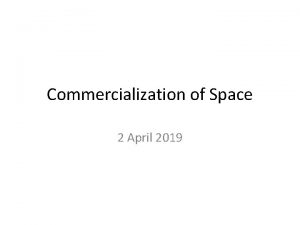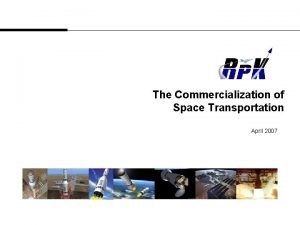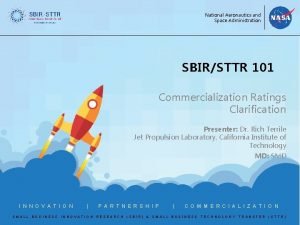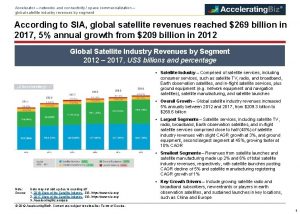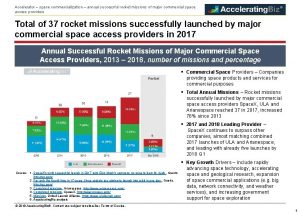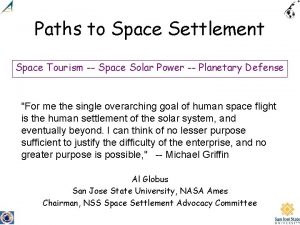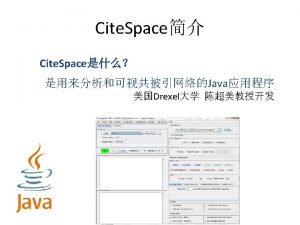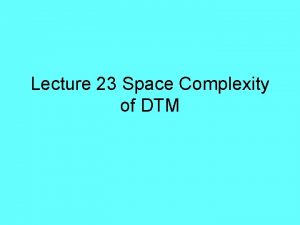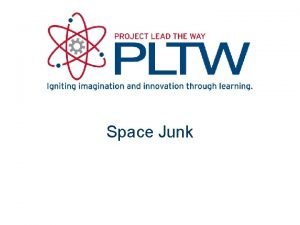Commercialization of Space 31 March 2015 Commercialization Use



















- Slides: 19

Commercialization of Space 31 March 2015

Commercialization • Use of equipment sent into or through outer space to provide goods and services of commercial value • Example: Telstar 1 (1962) demonstrated TV transmission • Example: Syncom 3 (1964) broadcast Olympics from Japan

History • NASA has always spent most of its funding on private companies: • Aerospace corporations, launch service providers, subcontractors, universities • Department of Defense similarly • It has also fostered commercial activities in space: • Communications, microgravity uses, manufacturing


Initial NASA Approach • Specifications and control by NASA • Providers are sub-contractors, must meet NASA specs • Profits and incentives determined by NASA


Outer Space Treaty (1967) • Does not allow national claims of territory • Requires governments to supervise their citizen’s activities • Vague on liabilities, definitions, procedures • Did not envision all possible activities • Do possible commercial activities violate the treaty?

Commercial Space Ventures • Communications: highly profitable, supports direct broadcasting • Satellite navigation • Natural resources and remote sensing: never supported itself, until Google used free images • Launch vehicles • Transport to ISS to replace Shuttle, Russians • Tourism: expensive but popular • Mining: technically and economically feasible?


New Paradigm for Commercialization • NASA will purchase complete services for a fixed fee • Contractor decides how to meet specifications • Competition drives innovation and reduces price • NASA concentrates more on deep space and exploration

Selection of Boeing and Space. X (2014) • Selection of Boeing and Space. X as the providers of a U. S. -based capability to take humans to the International Space Station (ISS) is a major milestone in the almost sixdecade history of space exploration. It is just the latest sign that the old paradigm of government-only space travel is being replaced by something else -- a new business ecosystem composed of novel relationships among NASA and the aerospace industry

• No longer will NASA own the ISS "trucking company" -- specifying every nut and bolt. Instead, NASA is buying services from U. S. industry. To be sure, the new announcement made it clear that NASA will be carefully examining the safety aspects of each design. But the designs will still be those of Boeing and Space. X and vetted by NASA.

• the rest of the world is still stuck in a nearly government-only mode, NASA, with the support of the Obama administration, is letting loose the creativity of American knowhow. • G. Scott Hubbard, Stanford University

• Beginning with the NASA Commercial Orbital Transportation Services competition, continuing with the Commercial Resupply Services (cargo) and now the Commercial Crew selection, NASA "bet the farm" on commercial companies filling the gap left by the retirement of the space shuttle, with the Commercial Crew companies (Space. X and Boeing) replacing the Russians in bringing NASA astronauts to the ISS. This will allow NASA to invest the savings in deep space capabilities such as SLS and Orion.

• NASA's proper role can be summed up in three words: "Explore Deep Space. " It is time for NASA to turn over the low Earth orbit work to industry while NASA focuses on getting humanity to Mars, following in the tracks of robotic rovers Spirit, Opportunity and Curiosity. History teaches us that without a trailing edge of commercial exploitation and profitability, exploration as large scale, routine human endeavor will not succeed.

Reasons for Government Support • Financial market insufficient – High uncertainty and/or risk – Large fixed costs – Long lead times for payback • Examples: Nuclear power, airmail


Results of recent launch failures • Examples: OSC Antares, Space. X Falcon 9 • Show some risks and also recovery strategies

Summary • Many uncertainties: Technical and economic feasibility still not demonstrated • US has good record of fostering commerce • New paradigm may allow more focus on exploration • Government is still the principal market
 Poland national anthem lyrics
Poland national anthem lyrics Disadvantages of commercialisation in sport
Disadvantages of commercialisation in sport Technology commercialization process model
Technology commercialization process model Disadvantage of green revolution
Disadvantage of green revolution Unscented trajectory chapter 5
Unscented trajectory chapter 5 Space junk the space age began
Space junk the space age began Camera space to world space
Camera space to world space Unscented trajectory chapter 5
Unscented trajectory chapter 5 World space computer
World space computer Grihalakshmi magazine march 2019
Grihalakshmi magazine march 2019 Where was van gogh born
Where was van gogh born Genetic engineering conclusion
Genetic engineering conclusion March 1917 revolution
March 1917 revolution Sherman's march to the sea route
Sherman's march to the sea route Sherman's march significance
Sherman's march significance Path of sherman's march to the sea
Path of sherman's march to the sea Path of sherman's march to the sea
Path of sherman's march to the sea Mist tccc
Mist tccc Che guevara aleida march de la torre
Che guevara aleida march de la torre March april may season
March april may season




















